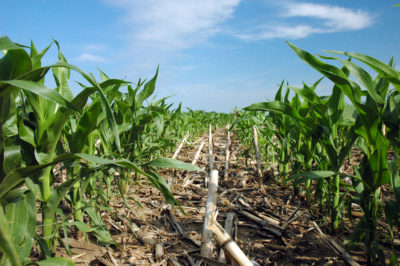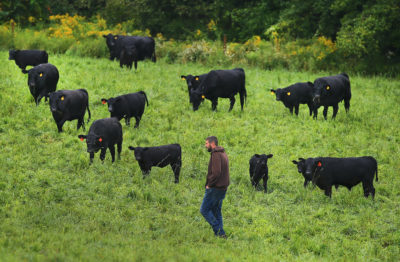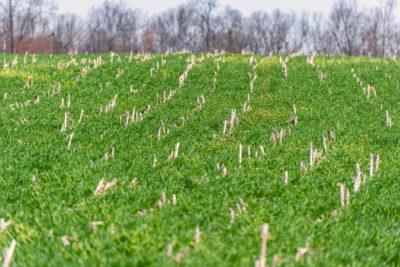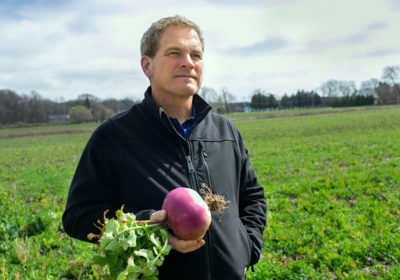A new kind of food may soon be arriving on grocery store shelves: climate smart. Under the Partnerships for Climate-Smart Commodities, a nascent U.S. Department of Agriculture (USDA) program, this amalgam of farming methods aims to keep the American agricultural juggernaut steaming ahead while slashing the sector’s immense greenhouse gas footprint.
This spring, the Biden administration began allocating $3.1 billion to hundreds of agriculture organizations, corporations, universities, and nonprofits for climate-smart projects. These entities will pass most of the money on to tens of thousands of farmers, ranchers, and forest owners, including growers who manage thousands of acres and underserved and disadvantaged farmers who often have much smaller operations. The first agreements have now been signed; the money is starting to flow.
The USDA estimates that the 141 funded projects will, collectively over the project’s five-year lifetime, eliminate or sequester the equivalent of 60 million metric tons of carbon dioxide emissions, on par with removing more than 2.4 million gas-powered cars from the road over the same period. They will achieve this by paying growers to adopt practices thought to either reduce greenhouse gas emissions or capture carbon dioxide from the air. These practices include reducing or eliminating tilling of soil, planting “cover crops” that grow during the off-season and are not harvested, improving how farmers use fertilizer and manure, and planting trees.
The market for climate-smart products “is potentially massive — much bigger than any federal program could be.”
More importantly, the agency aims to catalyze new, premium markets for products such as climate-smart corn, soybeans, and beef, which it hopes will spur farmers to continue these practices far into the future. “People want to know that when they’re spending their dollar at the grocery store that they’re not hurting the environment; they want to be helpful,” Agriculture Secretary Tom Vilsack said last December when announcing projects that received funding. The emerging market for climate-friendly products, he added, represents “a transformational opportunity for U.S. agriculture.”
The idea has enthusiastic supporters. The market that Vilsack envisions “is potentially massive — much bigger than any federal program could be,” says Ben Thomas, senior policy director for agriculture at the Environmental Defense Fund. “And it’ll last as long as the conditions that create the market still exist.”
But the high-profile effort has also come under fire. Some researchers fear that the agency lacks a workable plan for measuring and verifying the impacts of the practices federal dollars will be paying for. Others say science has yet to prove that climate-smart practices truly reduce greenhouse gas emissions. “We don’t have that understanding yet for most climate-smart management practices,” says Kim Novick, an environmental scientist at Indiana University.
The program’s harshest critics assail it as a giveaway to rich corporations that will do little to rein in climate change — and might even exacerbate it. “This program is just pork for big polluters,” says University of Iowa economist Sylvia Secchi. “It’s a greenwashing scheme. It’s going to allow nothing to get done.”
For decades, efforts to cut fossil fuel emissions have focused on power plants, factories, and automobiles, not farmland. “Agriculture has just not been at the table in a meaningful way,” says Thomas.
But it should be. For all of industrial farming’s success at feeding people and livestock and producing biofuel, the sector is also a major polluter, accounting for roughly 10 percent of U.S. greenhouse gas emissions and roughly a quarter of emissions globally. The main greenhouse gases emitted by U.S. agriculture today are nitrous oxide, which comes mainly from soil microbes that digest nitrogen fertilizer, and methane, burped by the nation’s roughly 92 million cows. Both warm the atmosphere far more, per molecule, than carbon dioxide.
Farmland itself was also once a major source of atmospheric carbon dioxide as farmers cleared carbon-rich forests and plowed up prairie soils, releasing carbon from trees and the ground. Now, climate-smart agriculture aims to recapture some of that carbon.
Helping farmers reduce tillage and plant cover crops improves water quality and reduces erosion, says a program advocate.
Unlike with organic farming, climate-smart farming has no list of allowed or prohibited practices. “There is no single definition of climate smart,” says Omanjana Goswami, an interdisciplinary scientist at the Union of Concerned Scientists. Instead, it comprises a mélange of practices that, studies show, can either reduce farms’ greenhouse gases emissions or increase the amount of carbon stored in their soils.
Funded projects are receiving up to $95 million over five years to help farmers take up these practices and to create monitoring and marketing programs that, it’s hoped, will keep farmers on the climate-smart track after the program ends. That all-carrot, no-stick strategy is intentional and necessary to reduce agriculture’s climate impact, says Robert Bonnie, under secretary for farm production and conservation at USDA and one of the program’s chief architects and champions.
“A voluntary, collaborative approach is the only approach that works here,” says Bonnie. “Regulation isn’t very good at asking people to adopt new practices.”
The department says the program will deliver benefits to underserved and disadvantaged farmers, a group that includes farmers of color, women, veterans, and small and beginning farmers who have, in the past, struggled to access USDA funding streams and have sometimes been intentionally excluded from them. Many of the projects whose signed agreements have been made public, for example, will direct at least 20 percent of funds to underserved farmers.
Farmer Ryan MacKay oversees grass-fed cows on a pasture in Hudson, Massachusetts.
John Tlumacki / The Boston Globe via Getty Images
Champions of the program also note that expected benefits go beyond increasing carbon sequestration and reducing greenhouse gases from farm fields. By encouraging farmers to reduce tillage, plant cover crops, and take other measures, “we’re improving water quality; we’re reducing erosion,” says Adam Kiel, executive vice president of AgOutcomes, which is managing a $95 million climate-smart partnership led by the Iowa Soybean Association.
But as the climate-smart commodities program gets underway, many experts are warning that even its most-touted practices often fall far short. For example, some cover crop studies have found that the practice did not sequester significant amounts of carbon in soils, while other studies that did find gains also had gaps or methodological problems that diminished confidence in the results. And an analysis published in May in Nature Sustainability found that yield losses resulting from cover crops in the United States could erase as much as 70 percent of their climate benefits if farmers cut down trees elsewhere or plow up grasslands to compensate for those losses.
“I wouldn’t say we should pause everything, because there are some real benefits to cover cropping,” says David Lobell, a food security researcher at Stanford University and a coauthor of the Nature paper. “But I think we should be much more vigilant about maintaining productivity” as more farmers start using cover crops.
Few long-term assessments of any climate-smart practices have been conducted on working farms, says a scientist.
Other projects aim to reduce the greenhouse gas footprint of beef and dairy herds by more carefully managing how these animals graze pastures, so their manure can feed perennial grasses and other plants whose roots pull carbon deep into the soil. But grass-fed cows can also emit significantly more methane over their lifetimes than those that spend more of their lives in feedlots. Some projects plan to feed cows experimental additives that could reduce those methane emissions.
Measuring and modeling nitrous oxide emissions accurately is also notoriously difficult. And practices thought to reduce such emissions — like applying some fertilizer in the spring, just before planting, rather than applying all fertilizer in the fall — sometimes backfire. In fact, few long-term assessments of any climate-smart practices have been conducted on working farms, says Novick, making it hard to tailor practices to particular soil types, climates, and situations.
“It doesn’t appear that funding decisions from this program were necessarily made in a way that maximizes climate mitigation,” says Novick, who led a team that last fall authored a report on how science can inform nature-based climate solutions. “Ideally we would have first invested in the data tools necessary to understand when and where a practice is likely to succeed as a climate solution.”
Cover crops grow amid old corn stalks in Maryland, helping to store carbon in the soil.
Edwin Remsberg / Alamy Stock Photo
There’s also the question of how to measure the program’s benefits. Funded groups are required to take measurements that will allow the USDA to assess the impacts of the practices farmers are implementing. But the agency is also relying heavily on a computer model that was designed to estimate greenhouse gases for planning large-scale projects and that cannot accurately quantify emissions and carbon capture from individual farms, notes Jon Sanderman, a soil scientist at the Woodwell Climate Research Center.
Bill Hohenstein, director of the USDA’s Office of Energy and Environmental Policy, acknowledges that the science behind climate-smart agriculture remains a work in progress. But he says it’s mature enough to take action. “We could wait a decade and probably understand these benefits better,” Hohenstein says. “But our view is that we would end up with generally the same recommendations.”
In addition to the technical challenges of measuring carbon and greenhouse gas changes, the Climate-Smart program will have to get farmers to stick with new practices after payments have ended. Officials say that payments to cover the startup costs for enrolled farmers are essential. “If this stuff was free, folks would already be doing it,” Bonnie says. But once they’ve bought equipment like seed drills for no-till planting and climbed the learning curve, he and Hohenstein say, reduced input costs, yield increases resulting from healthier soils, and premiums for climate-smart products will start to pay for themselves.
One economist questions why some of the wealthiest agricultural corporations are receiving additional federal money.
Many experts view such projections as overly optimistic. Hanna Poffenbarger, a soil scientist at the University of Kentucky, says it may take a decade for cover crop benefits, such as reduced need for fertilizer and increased soil organic matter, to translate into profits. That aligns with the experience of early adopters like Trey Hill, a farmer in Maryland who says that even after planting cover crops for more than 20 years, he’s still seeing yield losses in some of his corn fields and an unclear impact on his bottom line. “When you talk about improving soils,” he says, “we’re talking about a 10-year commitment before you would really even see anything significant.”
Details on the projects themselves have been slow to emerge. Though the projects receiving the bulk of the funding were announced last September, the USDA has so far shared fewer than a quarter of the signed agreements on its website. For the remaining projects, the department has published scant information. For example, a $61-million project led by the agribusiness giant Tyson to create and market “climate-smart beef” comes with only a two-sentence description that does not explain what practices will make beef climate smart. In response to an interview request, a Tyson representative linked to a blog post lacking substantive information on how the company’s claims will be verified.
The vagueness troubles observers like Goswami, of the Union of Concerned Scientists, who says that without clear standards, companies will define “climate smart” in different ways, potentially confusing customers. “If Tyson comes in and says farms and ranches who we’re buying cows from have implemented X amount of cover cropping, does that make their beef climate smart?” she asks.
Even people who received funding fear that the program could overwhelm or confuse farmers who are suddenly inundated with competing climate-smart offers. “In Iowa alone, there are 17 different climate-smart projects” that will be recruiting farmers, Kiel notes. At the same time, another branch of the USDA, the Natural Resources Conservation Service, has been tasked with disbursing nearly $20 billion injected by the Inflation Reduction Act into farm programs, including ones that pay farmers to grow cover crops or set aside land for conservation. Private-sector carbon markets are also courting farmers. And many of these initiatives require that farmers not take money from competing programs, to avoid double counting of climate benefits. “There’s going to be farmer confusion,” Kiel says. “It’s unfortunate, but at least there’s going to be lots of choices.”
Secchi, meanwhile, questions why some of the wealthiest corporations and individuals in industrial agriculture are receiving additional federal money. She would have instead liked to see the government insist that growers already receiving government subsidies through other programs do more to reduce their climate impact. “Why can’t we ask farmers who are getting crop insurance subsidies to plant cover crops at zero extra cost for the taxpayer?” Secchi asks. She’d also like to see more of the funds directed toward minority, Indigenous, and other disadvantaged farmers.
Bonnie, the USDA undersecretary, responds that catalyzing large-scale change requires working with companies big enough to reach thousands of growers farming millions of acres. Building a program that will create new markets rather than new regulations and policies, he adds, insulates climate-smart agriculture from future Congresses and administrations that may be less climate friendly.
One thing is certain: As the government looks to steer the ocean liner that is American farming in a direction that’s climate friendlier yet still highly profitable, a lot of eyes — both hopeful and skeptical — will be watching closely.
This story was produced in collaboration with the Food & Environment Reporting Network, a nonprofit investigative news organization.




